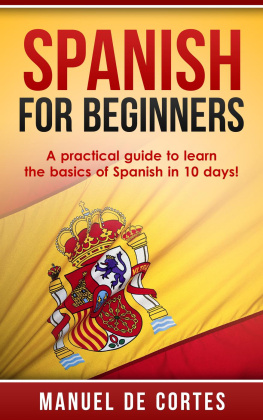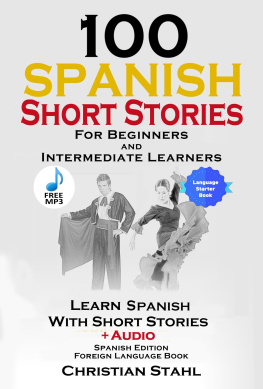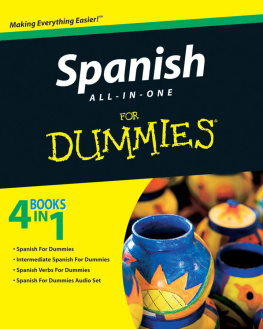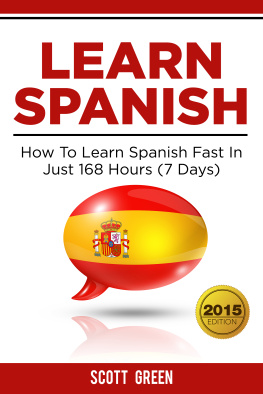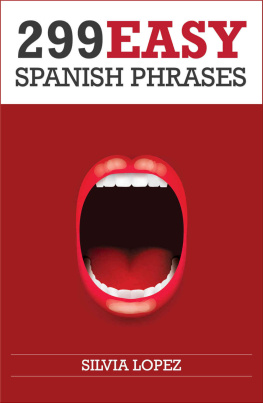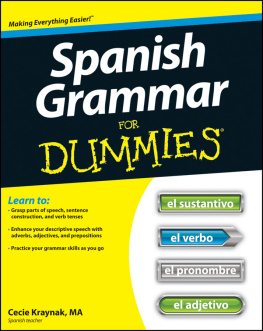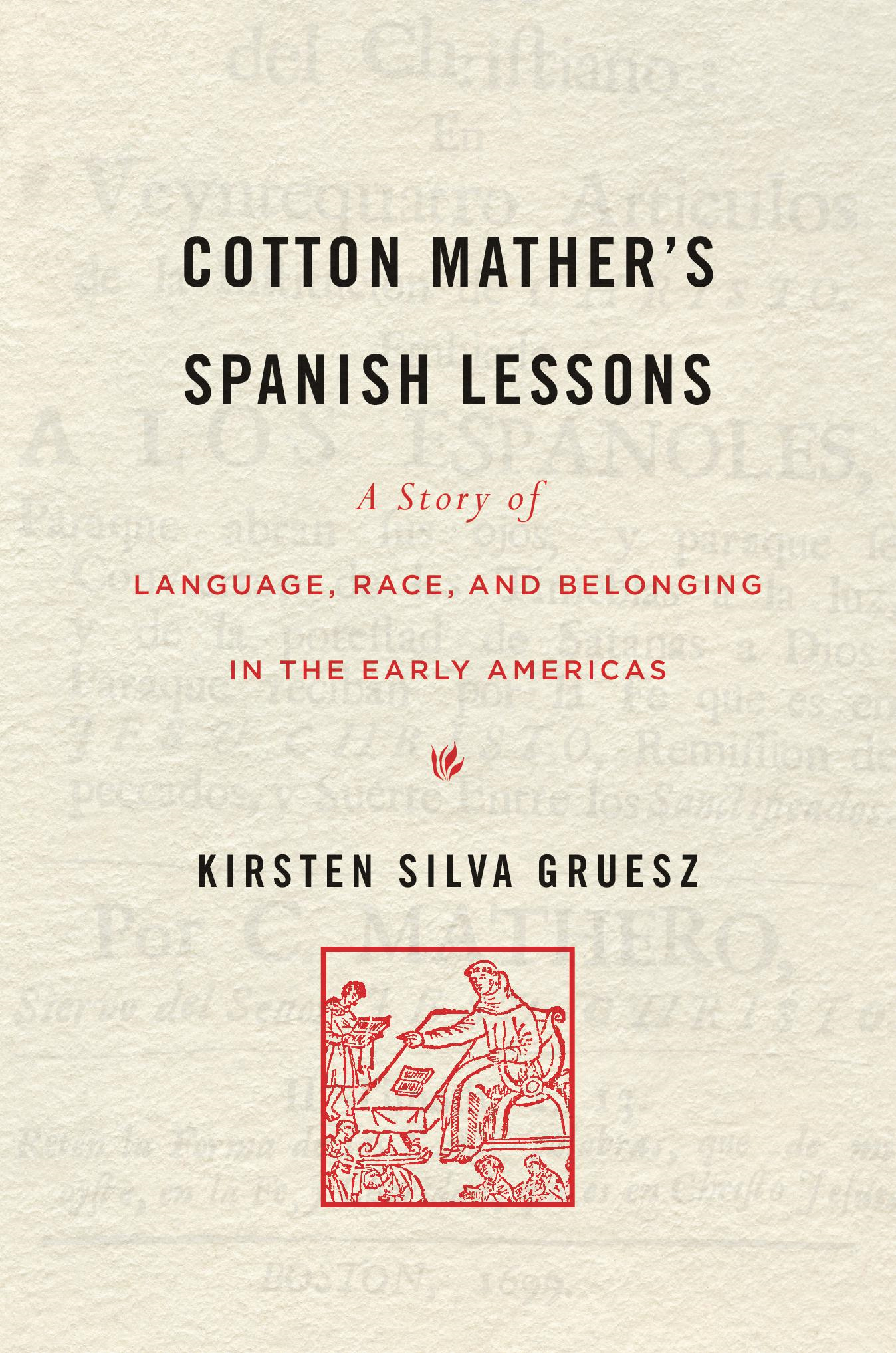Contents
List of Figures
Guide
Pagebreaks of the print version
COTTON MATHERS SPANISH LESSONS
A Story of Language, Race, and Belonging in the Early Americas
Kirsten Silva Gruesz
THE BELKNAP PRESS OF HARVARD UNIVERSITY PRESS
CAMBRIDGE, MASSACHUSETTS
LONDON, ENGLAND
2022
Copyright 2022 by the President and Fellows of Harvard College
All rights reserved
978-0-674-27569-0 (EPUB)
978-0-674-27568-3 (WEB PDF)
Background: Getty Images
Background type: AC7.M4208.699f Lobby VI.3.33. Houghton Library, Harvard University
Inset image: Francisco Pareja (d. 1628). Universal History Archive/UIG/Bridgeman Images
Cover design: Graciela Galup
Library of Congress Cataloging-in-Publication Data is available from loc.gov
ISBN: 978-0-674-97175-2 (cloth)
To Teodoro & Elias, my little birds grown: no olviden que tienen dos alas
CONTENTS
I have retained Mathers idiosyncratic spelling and capitalization and, when possible, his enthusiastic use of underlines, italics, and punctuation to highlight certain words and phrases in his printed works. Texts for reading aloud made use of these different styles to indicate emphasis and breath marks. They are the equivalent of performance scripts, and allow the reader to imagine the sonic qualities of Mathers oral delivery. In some cases, I have had to rely on printed transcriptions of these works that do not indicate such authorial preferences. One exception to this general fidelity to seventeenth- and eighteenth-century orthography is that I have spelled out his scribal abbreviations for common terms like which and the. For example, the thorn character, which looks like a y with a superscript e, was used as an abbreviation for the but is often represented as ye and thus confused with the second-person plural pronoun ye (you-all).
I have also followed period style in citations from Spanish. Todays orthography was standardized beginning in the early eighteenth century by the newly founded Real Academia Espaola, so earlier texts may use different spellings, as in Christiano: this is not an error on Mathers part. Citations of books in Spanish do not routinely capitalize most words in a title, as they do in English, but I hew to Mathers own usage in capitalizing Fe and Christiano, as his bibliographer Thomas Holmes and most library records have also done.
Mather, who lived on the cusp of the transition from the Julian to the Gregorian calendar, generally recorded both Old and New Style dates in letters and diaries. I follow most modern editions of his works in giving only the Gregorian dates to avoid confusion.
Unless otherwise indicated, all translations are mine, and are given in brackets in the text.
Flocks of tourists each year walk the red-painted lines that mark Bostons Freedom Trail, a secular pilgrims route of historical markers and monuments. Visitors with strong calves might hike along the steep incline leading to Copps Hill Burying Ground to view the graves of the citys early free Black activists and of the fire-and-brimstone preachers Cotton and Increase Mather, two Puritan ministers closely associated with the Salem witch trials, as the interpretive materials describe them. Larger crowds throng the less strenuous route toward the iconic Old North Church, associated with Paul Reveres ride. Near that building stood an even older, now-vanished landmark of North Square: the Second Church, presided over for seventy-five years by members of those same Mathers, who lived nearby. Less than a mile from here, the red sidewalk lines leadacross solid ground that had been water before the citys seventeenth-century founders filled it into Boston Common, where a sign proclaims, The Revolution begins here. In pointing out such connections between colony and nation, the Freedom Trail does its interpretive work: to induct visitors into a narrative of national becoming that centers this English settlement as the Puritan seed that would grow into the republic of the United States. But just a few steps off the marked path, a visitor might catch the sounds of something different: people singing, praying, and preaching in Spanish.
The sounds emanate from the Tremont Temple adjacent to Boston Common. Established in the nineteenth century as a racially integrated Baptist church, it was once an important site of abolitionist activity. Now the buildings basement houses a different congregation, the Iglesia Bautista Hispanoamericana de Boston. At first glance, these two congregationsthe imposing North Square churches of the past that housed some of the first Christian settlers and the Spanish-speaking evangelical church hidden from street view todayappear to have no connection with one another. Yet in many ways, the Tremont congregation represents the fulfillment of a vision that Cotton Mather had in the 1690s, when he set out to learn Spanish and to write tracts in that language. La Fe del Christiano (The Faith of the Christian) was the first Spanish-language publication in what would become the United States. Mather imagined these words on paper as a little Fire that would kindle a blaze of Protestant conviction across the vast zones of the Americas to the south of the little English town he barely ventured out of during his lifetime. That little Fire took only three hundred years to arrive at his front door.
If entering the old buildings along the Freedom Trail is a kind of public pedagogy that encourages visitors to feel a sense of continuity with the past, studying New Englands first books does the same in American history and literature classrooms. Both educational projects have been importantly revised in recent years to center other people besides English settlers. The popular Boston Black Heritage Trail leads by the nations oldest surviving church and school established by and for African Americans, while the Mamusse Wunneetupanatamwe Up-Biblum God (1663) is a rare and prized possession of many libraries: as the first complete Bible printed in British North America, a stunning technical and intellectual achievement of Wampanoag translator-printers, it proves that there was once a will to embrace languages other than English within the colony. By taking back the living, spoken language from these books, centuries later, the Wampanoag community has turned them into powerful symbols of cultural survival and persistence. Claiming a part in these foundational stories is a different matter for Latinos like the ones gathered in the Tremont Temple basement. Most identify as having a mixed-race ancestry that is captured by neither a US Black / white racial binary nor Native tribal enrollment standards. Their families residency in the United States may stretch back a few generations, but it is more likely to be recent. If Mathers La Fe del Christiano is the first Spanish-language imprint within the nations current borders, should it be considered the first Latino text? What manner of thread connects this fragile artifact to the present?
Mather understood the world in terms of a contest between his Gods revealed truth and an array of other religious faiths he regarded as false, chief among them Roman Catholicism. Any gratification he might feel to know that Latinos make up the fastest-growing demographic of evangelical Protestants in the country today would be tempered by the fact that the archdiocese of Boston maintains a robust Apostolado Hispano (Hispanic ministry), which seeks to keep this same population within the Catholic fold. For most US Americans, however, the competition among different sects of Christianity long ago ceded its importance to a different kind of struggle, one waged over the way the nation remembers its collective past, its distribution of rights and opportunities in the present, and its openness to making new citizens through immigration in the future. This is a struggle about inclusion and belonging, pitting those who claim longstanding or ancestral presence in the country against those who are perceived as outsiders and strangers. So contentious is the question that it has kept immigration policy paralyzed for decades, leaving some eleven million US residents stranded in the legal limbo of the undocumented: semivisible participants in the nations social, economic, and religious life without enjoying the full rights of citizenship. Millions of other would-be immigrants are detained and deported at its borders and from within its cities. Although these persons come from all over the globe, more than 80 percent are from Latin America. Thus, in the medias nuance-flattening way, the prototypically undesirable migrant comes from south of the border, speaks Spanish, and looks Brown.


